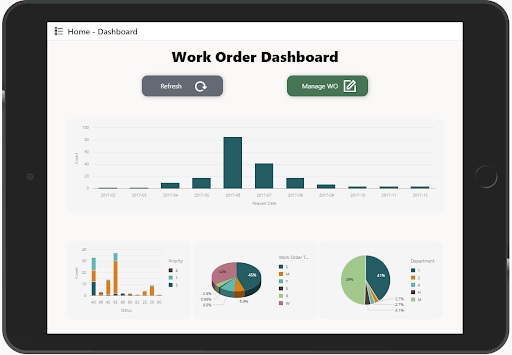Our Approach to Building Oracle VBCS Mobile Apps for Maintenance WO's
One of the more common use cases for creating mobile apps using the Visual Builder Cloud Service (VCBS) is building a maintenance work order app. This use case is applicable for a wide array of industries including manufacturing, food and beverage, oil & gas, etc. but for this discussion, let’s consider an airport authority. This app needs to allow their various departments to enter work orders and maintenance requests whether workers are in the terminal or on the tarmac.
Having a progressive web app (PWA) that would render on iPhone and Android tablets is important for this type of organization and its Operations team. They might have someone out on the tarmac dealing with a broken jet bridge or someone in the baggage handling area needing parts for a conveyor. With a virtually unlimited number of components that can break, they require a real-time system with full-featured data access to manage all the moving parts of work orders.
Key Features and Requirements for Mobile Maintenance Request & Work Order Entry
Dynamic & Responsive Data Management: Because of the type of mobile devices (iPads) being used in Operations and Maintenance, there is the ability to show a substantial amount of information on the screen with tables that pull information from JDE. The drop downs on these screens are dynamic, so if a new code is added in the system it is immediately updated and the changes are available in the mobile app for all users.
Attachment Capabilities: Work orders and maintenance requests can be complicated and require more communication than the options available from a menu. Additional notes or pictures are often required. Using the Orchestrator’s capabilities around attachments, it’s possible to take input from the mobile application and add it to the system as a JDE attachment.
Low Latency: There’s no time to waste when getting airport equipment back in service. This means getting data in and out of the maintenance system needs to be fast as well. Using VBCS with REST connections means we are sending data in smaller pieces, delivering an application experience that is responsive with low latency.
Error Visibility: Error codes are also quickly communicated to provide immediate feedback (for example, if a user enters information that’s the wrong type for a specific field). Standard or custom error messages generated in JDE can be automatically pushed to the mobile app user. This helps information move faster and limits bottlenecks due to errors.
Offline Availability: Airport maintenance requests need to be received in real time for immediate action. However, connectivity isn’t guaranteed in every situation. The framework makes it easy to implement offline capability so that a user can enter data, hit submit, and know their order will go through right away when the connection is regained.
Data Visualization: This was a bonus feature we added because it was easy to do and can provide value over time. We built out data dashboards that break down work orders by month, year over year, by department, open vs. closed work orders, and types of work orders (preventive, corrective, etc.). Data can be refreshed automatically (or manually) in a few seconds. With the available widgets, these analytics were fairly quick to set up using components from a standard library of charts, collections, layouts, navigation, and combo boxes. The visuals on the front end are easy to digest, and the components support advanced features. For example, users can drill down to the detail rows and columns of data on the back end inside the app.

Strong Security and Dynamic Scalability Come Standard
As with all our mobile app projects, the Orchestrator provides robust security and logic through JDE. And with the flexibility of Oracle VBCS, making changes in the UI is a low-code proposition, providing the opportunity for rapid change at a low cost. We look forward to seeing this app grow from its initial proof of concept to include even more features and functionality over time.
Click here to learn more about ACBM's approach to custom mobile application development.
Have old mobile apps that need a refresh? Or, is there a brand new use case that could optimize your operations? Contact us today for a free discovery call.

